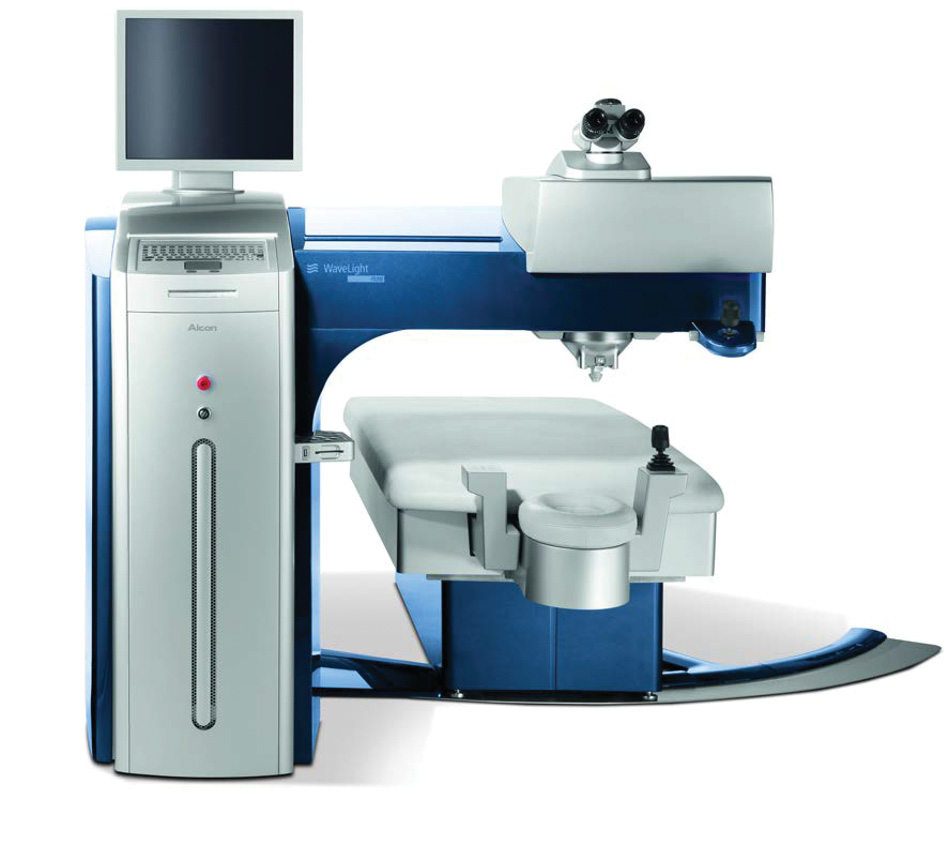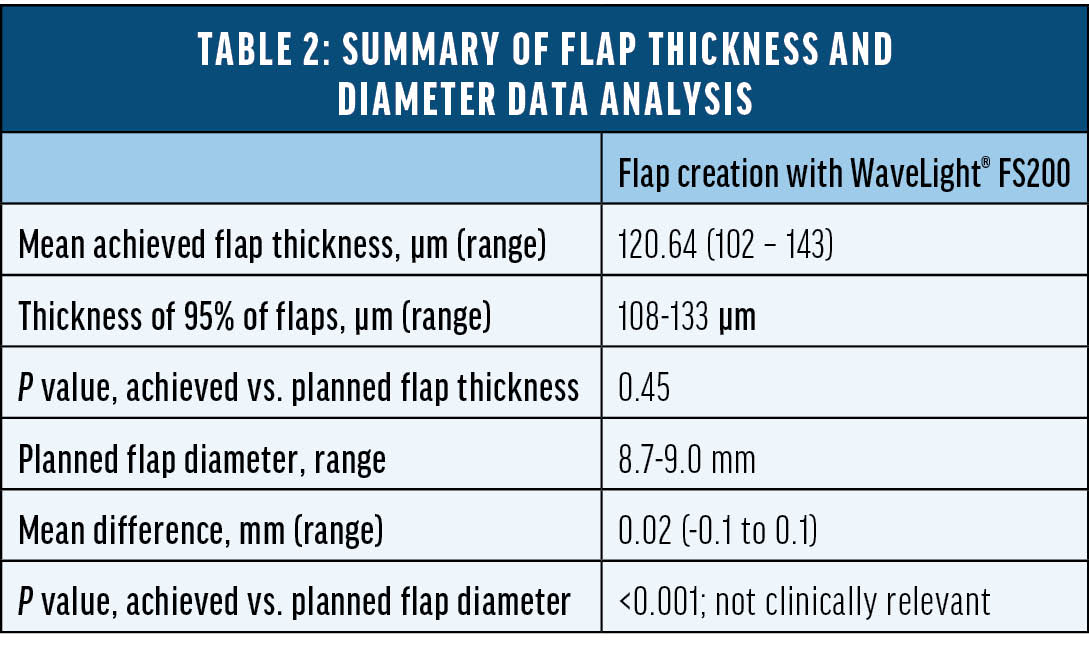Achieving a desired flap thickness and minimizing the variability of that thickness are crucial aspects of successful LASIK surgery. A specified flap thickness is needed for surgical planning, including calculation of the residual stromal bed thickness, to ensure that enough tissue remains to lessen the risk of postoperative ectasia. Therefore, it is critical that the achieved flap thickness matches what was planned. The WaveLight® FS200 Femtosecond Laser (Alcon) delivers accurate and reliable flap thickness, as well as flap diameter, allowing surgeons to feel confident in their surgical planning.1,2
WaveLight® FS200 Technology for Ensuring Accurate LASIK Flap Parameters
The WaveLight® FS200 Femtosecond Laser is most commonly used for LASIK flap creation, but can also be used for lamellar and penetrating keratoplasties, tunnel creation for intracorneal ring segment procedures, and for various corneal incisions (Figure 1). The laser works using a photodisruption process to separate corneal tissue by generating energy that produces tiny bubbles at a precise depth and location.3,4

Figure 1. WaveLight® FS200 Femtosecond Laser System.
The WaveLight® FS200 Femtosecond Laser uses a rapid firing speed of 200kHz along with customizable spacing and energy parameters to deliver fast, effective, and extremely reliable treatments. Additionally, the laser offers adjustable hinge positions and sizes, along with customizable side-cut angles, flap sizes, and shapes.3,4
For LASIK flap creation, the high repetition rate of the WaveLight® FS200 Femtosecond Laser can generate a standard 9-mm corneal flap in approximately 6.0 seconds and allows for low pulse energy. The efficiency of the procedure is further enhanced through the use of a ventilation tunnel that minimizes the build-up of an opaque bubble layer during the flap-cutting procedure. This allows the surgeon to perform the excimer laser ablation treatment right away without needing to wait for the bubbles to dissipate. These features of the WaveLight® FS200 Femtosecond Laser result in sharp cutting edges, smooth stromal beds, and easy-to-lift flaps.3,4
An important aspect of the WaveLight® FS200 laser is the calibration of the system to ensure consistency during the surgical procedure. Two instances of calibration occur. The first is an automated daily calibration when the laser is turned on to assure reliable and consistent performance. The second is a mandatory check just prior to applying the patient applanation cone to the corneal surface (Figure 2). During the second calibration, the distance between the focusing device and the anterior surface of the cone is measured to compensate for deviations in the applanation surface thickness. Compensations for temperature changes in the laser’s system components are also made during this step. Not only are these important safety features, but they importantly ensure consistent flap thickness with low standard deviation.1-4

Figure 2. The applanation cone approaching the corneal suction ring and prior to reaching the corneal surface.
Additional benefits offered by the WaveLight® FS200 are ease of use for the surgeon and comfort for the patient. When placing the suction ring, it is easy to center despite anatomical differences. Docking suction is achieved automatically, is adjustable, and allows for minimized intraocular pressure (IOP), and therefore more comfort for the patient. Another convenient aspect includes the auto-centration feature, which automatically centers the flap on the pupil, yet still allows the surgeon the option to customize placement of the flap for each individual case.3,4
Clinical Study Measuring LASIK Flap Thickness and Diameter Generated by the WaveLight® FS200
In a recent investigator-initiated study, the accuracy of flap thickness and diameter in patients undergoing LASIK surgery for myopia correction at a single surgical center was evaluated. This prospective, observational, single-arm study examined flap thickness in LASIK surgeries where the WaveLight® FS200 Femtosecond and EX500 lasers were used (both Alcon). The WaveLight® FS200 is designed to help surgeons generate custom flap thickness with precision and consistency. The EX500 features the ability to perform optical pachymetry, and this was used for measuring corneal thickness.2
This study included 58 individuals (n = 116 eyes) at an average age of 34.43 (range: 23-54) and included 32 males and 26 females. The average mean manifest refractive spherical equivalent was -3.18 D (range: -0.25 D to -5.75 D) (Table 1). In this study, preoperative pachymetry data was collected with the WaveLight® EX500 pachymeter on the day of surgery, just prior to creating the LASIK flap. After the flap was cut and lifted, the WaveLight® EX500 pachymeter was used again to measure the stromal bed thickness. The intended flap thickness was compared to the actual thickness achieved during surgery by subtracting the measured stromal bed thickness from the preoperative full corneal thickness. The planned flap thickness for all corneas was 120 μm.2

The results showed that the calculated flap thickness utilizing the WaveLight® EX500 pachymeter gave a mean achieved flap thickness of 120 μm, and there was no statistical difference (P = 0.45) between the planned and achieved flap thickness. Additionally, 95% of the flaps ranged in thickness from 108 μm to 133 μm and varied from the mean by +/- 12.5 μm (Table 2). The achieved flap diameter was determined by image analysis, and the difference between achieved and intended was calculated. The mean difference in flap diameter between planned and actual was 0.02 mm, and, while there was a statistical difference (P < 0.001), there was no clinical significance (Table 2).2

The results of this study showed that the WaveLight® FS200 laser is reliable for generating LASIK flaps and accurately creates a flap at the intended thickness and at the intended diameter.2 Surgeons can rely on the WaveLight® FS200 for surgical planning and can trust that the LASIK flap result will match the surgeon-specified parameters.
Conclusion
The WaveLight® FS200 Femtosecond Laser delivers fast, effective, customizable, and extremely reliable LASIK flap parameters. The features offered allow the device to be easy to use for the surgeon and also comfortable for the patient while delivering reliable and accurate results that the surgeon can trust.
Important Product Information about the WaveLight® FS200 Laser System
CAUTION: Federal (USA) law restricts this device to sale by, or on the order of, a physician. INDICATIONS: The WaveLight® FS200 Laser System is indicated for use in the creation of a corneal flap in patients undergoing LASIK surgery or other surgery or treatment requiring initial lamellar resection of the cornea; in patients undergoing surgery or other treatment requiring initial lamellar resection of the cornea to create tunnels for placement of corneal ring segments; in the creation of a lamellar cut/resection of the cornea for lamellar keratoplasty; and in the creation of a penetrating cut/incision for penetrating keratoplasty and for corneal harvesting. The WaveLight® FS200 delivery system is used in conjunction with a sterile disposable Patient Interface, consisting of pre-sterilized suction ring assemblies and pre-sterilized applanation cones, intended for single use. The WaveLight® FS200 Laser System should only be operated by, or under the direct supervision of, a trained physician with certification in laser safety and in the use of the WaveLight® FS200 Laser. CONTRAINDICATIONS: LASIK treatments are contraindicated in: Pregnant or nursing women; patients with a diagnosed collagen vascular, autoimmune or immunodeficiency disease; and patients who are taking one or both of the following medications: isotretinoin (Accutane*), amiodarone hydrochloride (Cordarone*). Flap Contraindications: Lamellar resection for the creation of a corneal flap using the WaveLight® FS200 laser is contraindicated if any of the following conditions exist. Potential contraindications are not limited to those included in this list: corneal edema; corneal lesions; hypotony; glaucoma; existing corneal implant; and keratoconus. Keratoplasty Contraindications: Penetrating cut/incision (for penetrating keratoplasty) is contraindicated in: any corneal opacity adequately dense to obscure visualization of the iris; descemetocoete with impending corneal rupture; previous corneal incisions that might provide a potential space into which the gas produced by the procedure can escape; and corneal thickness requirements that are beyond the range of the System. Other Considerations: The following conditions should also be considered: severe corneal thinning; subjects with pre-existing glaucoma; a history of steroid responsive rise in intraocular pressure; preoperative intraocular pressure greater than 21 mmHg in the operative eye; subjects with more than 1000 μm corneal thickness at the 9 mm peripheral zone; active intraocular inflammation; and active ocular infection. WARNINGS: Any treatment with the WaveLight® FS200 is not recommended in patients who have: systemic diseases likely to affect wound healing, such as connective tissue disease, insulin dependent diabetes, severe atopic disease or an immunocompromised status; a history of Herpes simplex or Herpes zoster keratitis; significant dry eye that is unresponsive to treatment; severe allergies; and a history of glaucoma or ocular hypertension. COMPLICATIONS: Possible complications which may result from flap cutting include (potential complications are not limited to those included in this list): corneal edema; corneal pain; epithelial ingrowth; epithelial infection; flap de-centration; incomplete flap creation; flap tearing or incomplete lift-off; free cap; photophobia; corneal inflammation, such as diffuse lamellar keratitis (DLK), corneal infiltrates and iritis; thin- or thick flaps; flap striae; and corneal ectasia (secondary keratoconus). ADVERSE EVENTS: Transient Light Sensitivity Syndrome (TLSS): Transient Light Sensitivity Syndrome is characterized by symptoms of mild to severe light sensitivity which manifests between two and six weeks postoperatively. Patients experience no decrease in uncorrected or best spectacle-corrected visual acuity. The incidence of this sensitivity was observed in approximately 1% of patients who undergo flap creation with a femtosecond laser.* Patients respond to the use of hourly topical steroids such as prednisolone acetate, and most report improvement within one week of treatment. Peripheral Light Spectrum (PLS): Peripheral Light Spectrum is a temporary phenomenon whereby patients report the perception of a spoke-like spectrum of light in the periphery of their vision. PLS has no clinical examination findings and no effect on visual acuity; however the potential diffractive effects may be bothersome to some patients. Reported in only a small amount of cases, the onset of symptoms occurs during the immediate postoperative period, and typically resolves within three months but may be slightly persistent in rare cases. The visual impact of PLS is clinically inconsequential for the vast majority of patients. ATTENTION: Please refer to a current WaveLight® FS200 Laser System Procedure Manual for a complete listing of the indications, complications, warnings, precautions, and side effects.
© 2023 Alcon Inc. 11/23 US-WL2-2300016
1. Mrochen M, Wüllner C, Krause J, Klafke M, Donitzky C, Seiler T. Technical aspects of the waveLight FS200 femtosecond laser. J Refract Surg. 2010;26(10):S833-S840.
2. Wexler AS, Hall B. Accuracy of Flap Thickness in LASIK Surgery. Presented at the American Society of Cataract and Refractive Surgery (ASCRS) Annual Meeting; May 5-8, 2023; San Diego, CA, USA
3. Kanellopoulos AJ. Innovations in femtosecond laser technology—the use of the WaveLight® FS200 Laser for flap cutting during LASIK surgery. Eur Ophthalmic Rev. 2010;4(1):40-43.
4. Alcon Data on File, 2017.

